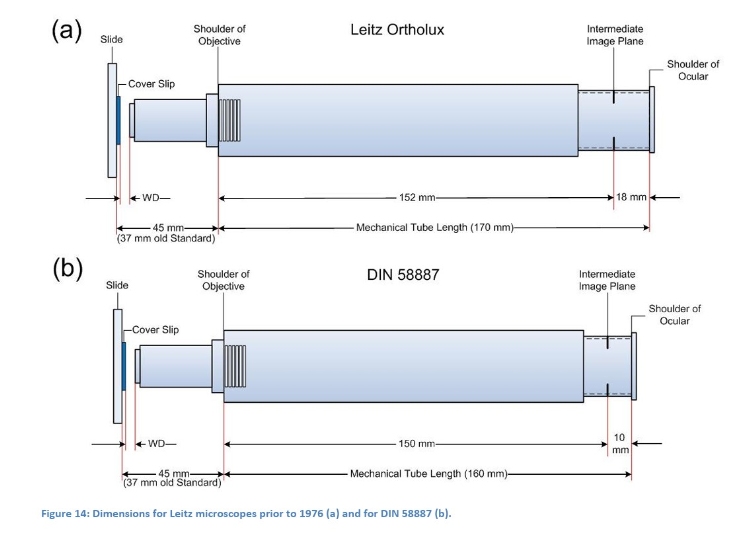www.fluorescencemicroscopy.it
Main menu:
- Home Page
- Microscopes
- Fluorescence
- Description
- Diascopy
- Epi-Fluoresc.
- Illumination
- Installing and Aligning a Mercury Lamp
- Fluorocromes
- Tables of Fluorocromes
- The Fading
- Wavelengths
- Properties
- % of transmission
- Types of filters
- Overlapping Spectra
- Intensity
- Image acquisition
- The Filter's set
- The Filters
- Fluorochrome's praparation
- Sample's preparations
- Fluorescence Sample
- Cytochemical Fluorescence
- Intrinsic Fluorescence
- Gallery
- Phase Contrast
- Polarization
- Darkfield
- DIC
- COL
- Rheinberg
- Brightfield
Objective Compatibility
Microscopes > Leitz ORTHOPLAN
Compatibility with new Leitz and non-Leitz objectives is of great importance to the microscopist using these types of microscopes. During the glory days of the "black" microscopes, Leitz offered objectives with two different parfocal distances. The older objectives used a parfocal distance of 37 mm ("short barrel") while the newer ones were designed for a parfocal distance of 45 mm. To combine the two different types on the same nosepiece (objective turret), Leitz offered special adapters called PLEZY and FLU-PLEZY. In 1976, with the introduction of the Leitz Dialux 20, Leitz adopted the German Standard Commission's DIN 58887 standard. DIN 58887 recommends a mechanical tube length (TL) of 160 mm. The Leitz Objective Specification Memorandum clearly states that in most cases objectives designed for a mechanical tube length of 160 mm can be successfully used on older Leitz microscopes, which use a mechanical tube length of 170 mm. Of course, eyepieces designed for a tube length of 170 mm can be used in all cases. Simply put, the reason for this backward compatibility is the fact that older Leitz microscopes use an optical tube length (or image distance) of 152 mm, which is only 2 mm longer than that proposed by DIN 58887 (150 mm). (See Figure below for details.)

For objectives with a magnification greater than 1:16, a 2 mm shift of the intermediate image has no noticeable effect on image quality. Roger P. Loveland plotted the tolerance for tube length change versus the NA of the objective in his excellent book on photomicrography. Loveland concludes that the tolerance for tube length change is affected only by the numerical aperture NA of the objective. Any dry lens with an NA of 0.80 or less should cope very well with a 2 mm difference in image distance. Even better, a difference of only 2 mm does not affect image formation when oil immersion objectives are used. The reason Leitz does not recommend using objectives with a magnification less than 1:16 is most likely because parfocality cannot be maintained. If parfocality is not desired, lower power objectives designed for a 160 mm TL may also be used. From the same Memorandum we can learn that newer eyepieces should not be used on older Leitz microscopes. Of course, when using an adjustable monocular viewing port, one may still be able to use newer eyepieces by appropriately reducing the length of the mechanical tube. The authors are successfully using an Olympus S-PLAN 40x objective and several Leitz objectives corrected for a mechanical tube length of 160 mm on these older microscopes.
Sub-Menu:
- The microscope
- Objective Compatibility ←
- Fluorescence Filter Blocks
- Fluorochromes x Filter Blocks